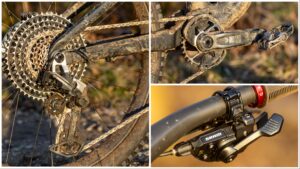Scott Genius 740 review, £2,399
The Scott Genius 740 may be the entry-level bike in the company’s new 650b line, but that hasn’t prevented it benefiting from the all latest that mtb technology has to offer.
Frame
Adaptability is the name of the game here, where a small asymmetric chip in the shock hardware makes it easy to choose between two geometry settings. The Scott Genius 740 ships in the low/slack setting, but since it is not particularly low for a 150mm-travel bike, we never felt the need to try the high/steep option.
Interchangeable rear dropouts make it possible to convert to a stiffer 142x12mm bolt-through rear end, but given how beefy the chainstays are, we doubt that it will be top of your list when it comes to upgrading. A dropper post, however, will be right up there, and guides are in place for both internal (Stealth) and external remotes. There’s also a quick-release seat collar (the only one in the test), even if the kinked seat tube prevents you from dropping the saddle very far.
Suspension
Scott’s handlebar-mounted TwinLoc remote is connected to both the rear shock and fork, making it easy to toggle between Lock, Ride and Descend suspension modes, or LRD for short. On the face of it, the TwinLoc suspension is as adaptable as the frame geometry, but this broad-brush approach to damping, which is very similar to Fox’s CTD technology, has one major drawback: you can’t adjust the fork or rear shock independently. You still get external rebound adjustment and spring rate to play with, but you won’t be able to, say, lock the shock out and have the fork in Ride mode.
Wheels
We’ve had mixed experiences on Nobby Nic tyres, but the dual compound 650b version on the Scott Genius 740 seemed to hook up nicely in dry, loose conditions. Maybe the bigger 650b wheels really do offer better traction. Shimano’s quick-release rear hub keeps the overall cost of the bike in check, but its limp 20° freehub engagement makes for delayed power transmission.
Groupset
No Shadow Plus rear mech is a major oversight on the Genius as the chain rattled, slapped and dropped off the chainrings just as the trails got interesting. Fortunately, there’s a neat guard bolted to the ISCG tabs on the BB to protect the frame, but the budget would have been better spent on a clutch rear mech.
Components
Scott has done a great job here — the stem and bar felt just right and the saddle was more comfortable than it looked.
Performance
To get the most from the Scott Genius 740 you need to integrate the TwinLoc lever into your riding routine, much in the same way as you would change gears to match the terrain. As such, we found that the rear shock bobbed a lot when cranking hard in Descend mode, and once we pointed the bike uphill, we really needed to switch to Ride to get more support from the rear. Unfortunately, this also made the fork sit higher, forcing us to lean forward more than normal to keep the front end down on the steepest climbs. Get the Genius into tight, twisty trails and the suspension response wasn’t stable enough in Descend, but switch to Ride and the fork was too firm, reducing steering grip.
On the downhill runs at Cwmcarn the Genius felt plush, especially when hanging off the back of the bike on the high-speed sections of trail. This could be down to the bigger wheels, but equally it could be due to the open valving of the suspension — the same lack of damping that had us reaching for the handlebar remote on every climb.
>>> Click here to find out more about geometry with our handy guide
Verdict
If you’re after a set-up-and-forget suspension bike, then the Scott Genius 740 probably isn’t for you, as the characteristics you might want for a go-anywhere set-up won’t be achievable using the TwinLoc’s three presets.
That’s not to say that the new Scott Genius 740 isn’t a decent package, but it feels more like a long-legged XC bike than a true 150mm-travel all-mountain ripper. If viewed as such it hits the mark, but with stiff competition from bikes like the Specialized Stumpy Evo Comp and Norco Sight 2, the bigger wheels on the Genius simply weren’t enough to win us over.
MBR rating: 7
Specification
Frame 6061 custom butted aluminium
Shock Scott DT Swiss LRD
Fork Fox 34 Float LRD
Wheels Formula/Shimano hubs, Syncros rims, Schwalbe Nobby Nic 2.25in
Brakes Shimano Deore 180mm
Drivetrain Shimano Deore crank, XT r-mech, SLX f-mech, Deore shifters
Components Syncros
Sizes S, M, L, XL
Weight 13.8kg (30.4lb)
Contact scott-sports.com
Angle Finder
Size tested M
Head angle 67.5°
Seat angle 67.6°
BB height 345mm
Chainstay 440mm
Front centre 715mm
Wheelbase 1,155mm
Down tube 685mm
This test appeared in the April 2013 issue of MBR alongside the Jamis Nemesis, Kona Explosif 27.5 and Norco Range Killer B-2. For more Scott reviews, check out the Scott Spark 950, Scott Scale 29 Comp and Scott Scale Elite 29.
















